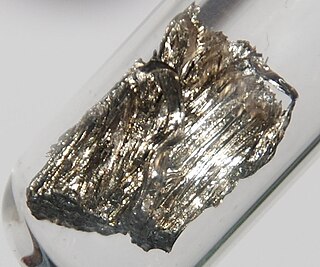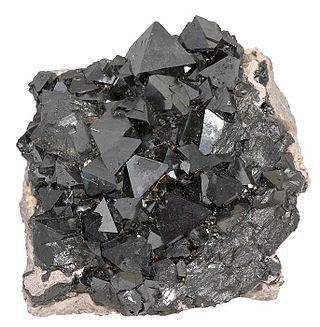Related Research Articles

Hematite, also spelled as haematite, is a common iron oxide compound with the formula, Fe2O3 and is widely found in rocks and soils. Hematite crystals belong to the rhombohedral lattice system which is designated the alpha polymorph of Fe
2O
3. It has the same crystal structure as corundum (Al
2O
3) and ilmenite (FeTiO
3). With this it forms a complete solid solution at temperatures above 950 °C (1,740 °F).

Samarium is a chemical element; it has symbol Sm and atomic number 62. It is a moderately hard silvery metal that slowly oxidizes in air. Being a typical member of the lanthanide series, samarium usually has the oxidation state +3. Compounds of samarium(II) are also known, most notably the monoxide SmO, monochalcogenides SmS, SmSe and SmTe, as well as samarium(II) iodide.

High-temperature superconductors are defined as materials with critical temperature above 77 K, the boiling point of liquid nitrogen. They are only "high-temperature" relative to previously known superconductors, which function at even colder temperatures, close to absolute zero. The "high temperatures" are still far below ambient, and therefore require cooling. The first break through of high-temperature superconductor was discovered in 1986 by IBM researchers Georg Bednorz and K. Alex Müller. Although the critical temperature is around 35.1 K, this new type of superconductor was readily modified by Ching-Wu Chu to make the first high-temperature superconductor with critical temperature 93 K. Bednorz and Müller were awarded the Nobel Prize in Physics in 1987 "for their important break-through in the discovery of superconductivity in ceramic materials". Most high-Tc materials are type-II superconductors.

In materials that exhibit antiferromagnetism, the magnetic moments of atoms or molecules, usually related to the spins of electrons, align in a regular pattern with neighboring spins pointing in opposite directions. This is, like ferromagnetism and ferrimagnetism, a manifestation of ordered magnetism. The phenomenon of antiferromagnetism was first introduced by Lev Landau in 1933.

Magnetite is a mineral and one of the main iron ores, with the chemical formula Fe2+Fe3+2O4. It is one of the oxides of iron, and is ferrimagnetic; it is attracted to a magnet and can be magnetized to become a permanent magnet itself. With the exception of extremely rare native iron deposits, it is the most magnetic of all the naturally occurring minerals on Earth. Naturally magnetized pieces of magnetite, called lodestone, will attract small pieces of iron, which is how ancient peoples first discovered the property of magnetism.

Yttrium barium copper oxide (YBCO) is a family of crystalline chemical compounds that display high-temperature superconductivity; it includes the first material ever discovered to become superconducting above the boiling point of liquid nitrogen [77 K ] at about 93 K.

Iron(II,III) oxide, or black iron oxide, is the chemical compound with formula Fe3O4. It occurs in nature as the mineral magnetite. It is one of a number of iron oxides, the others being iron(II) oxide (FeO), which is rare, and iron(III) oxide (Fe2O3) which also occurs naturally as the mineral hematite. It contains both Fe2+ and Fe3+ ions and is sometimes formulated as FeO ∙ Fe2O3. This iron oxide is encountered in the laboratory as a black powder. It exhibits permanent magnetism and is ferrimagnetic, but is sometimes incorrectly described as ferromagnetic. Its most extensive use is as a black pigment (see: Mars Black). For this purpose, it is synthesized rather than being extracted from the naturally occurring mineral as the particle size and shape can be varied by the method of production.
Magnetic semiconductors are semiconductor materials that exhibit both ferromagnetism and useful semiconductor properties. If implemented in devices, these materials could provide a new type of control of conduction. Whereas traditional electronics are based on control of charge carriers, practical magnetic semiconductors would also allow control of quantum spin state. This would theoretically provide near-total spin polarization, which is an important property for spintronics applications, e.g. spin transistors.

Mott insulators are a class of materials that are expected to conduct electricity according to conventional band theories, but turn out to be insulators. These insulators fail to be correctly described by band theories of solids due to their strong electron–electron interactions, which are not considered in conventional band theory. A Mott transition is a transition from a metal to an insulator, driven by the strong interactions between electrons. One of the simplest models that can capture Mott transition is the Hubbard model.
Strongly correlated materials are a wide class of compounds that include insulators and electronic materials, and show unusual electronic and magnetic properties, such as metal-insulator transitions, heavy fermion behavior, half-metallicity, and spin-charge separation. The essential feature that defines these materials is that the behavior of their electrons or spinons cannot be described effectively in terms of non-interacting entities. Theoretical models of the electronic (fermionic) structure of strongly correlated materials must include electronic (fermionic) correlation to be accurate. As of recently, the label quantum materials is also used to refer to strongly correlated materials, among others.

Vanadium(IV) oxide or vanadium dioxide is an inorganic compound with the formula VO2. It is a dark blue solid. Vanadium(IV) dioxide is amphoteric, dissolving in non-oxidising acids to give the blue vanadyl ion, [VO]2+ and in alkali to give the brown [V4O9]2− ion, or at high pH [VO4]4−. VO2 has a phase transition very close to room temperature (~68 °C (341 K)). Electrical resistivity, opacity, etc, can change up several orders. Owing to these properties, it has been used in surface coating, sensors, and imaging. Potential applications include use in memory devices, phase-change switches, passive radiative cooling applications, such as smart windows and roofs, that cool or warm depending on temperature, aerospace communication systems and neuromorphic computing.
A half-metal is any substance that acts as a conductor to electrons of one spin orientation, but as an insulator or semiconductor to those of the opposite orientation. Although all half-metals are ferromagnetic, most ferromagnets are not half-metals. Many of the known examples of half-metals are oxides, sulfides, or Heusler alloys. Types of half-metallic compounds theoretically predicted so far include some Heusler alloys, such as Co2FeSi, NiMnSb, and PtMnSb; some Si-containing half–Heusler alloys with Curie temperatures over 600 K, such as NiCrSi and PdCrSi; some transition-metal oxides, including rutile structured CrO2; some perovskites, such as LaMnO3 and SeMnO3; and a few more simply structured zincblende (ZB) compounds, including CrAs and superlattices. NiMnSb and CrO2 have been experimentally determined to be half-metals at very low temperatures.
Metal–insulator transitions are transitions of a material from a metal to an insulator. These transitions can be achieved by tuning various ambient parameters such as temperature, pressure or, in case of a semiconductor, doping.

Lanthanum strontium manganite (LSM or LSMO) is an oxide ceramic material with the general formula La1−xSrxMnO3, where x describes the doping level.
Charge ordering (CO) is a phase transition occurring mostly in strongly correlated materials such as transition metal oxides or organic conductors. Due to the strong interaction between electrons, charges are localized on different sites leading to a disproportionation and an ordered superlattice. It appears in different patterns ranging from vertical to horizontal stripes to a checkerboard–like pattern , and it is not limited to the two-dimensional case. The charge order transition is accompanied by symmetry breaking and may lead to ferroelectricity. It is often found in close proximity to superconductivity and colossal magnetoresistance.
A Mott transition is a metal-insulator transition in condensed matter. Due to electric field screening the potential energy becomes much more sharply (exponentially) peaked around the equilibrium position of the atom and electrons become localized and can no longer conduct a current. It is named after physicist Nevill Francis Mott.
Evert Johannes Willem Verwey, also Verweij, was a Dutch chemist, who also did research in physical chemistry.
Caesium sesquioxide is a chemical compound with the formula Cs2O3 or more accurately Cs4O6. It is an oxide of caesium containing oxygen in different oxidation states. It consists of caesium cations Cs+, superoxide anions O−2 and peroxide anions O2−2. Caesium in this compound has an oxidation state of +1, while oxygen in superoxide has an oxidation state of −1/2 and oxygen in peroxide has an oxidation state of −1. This compound has a structural formula of (Cs+)4(O−2)2(O2−2). Compared to the other caesium oxides, this phase is less well studied, but has been long present in the literature. It can be created by thermal decomposition of caesium superoxide at 290 °C.
Neodymium nickelate is a nickelate of neodymium with a chemical formula NdNiO3. In this compound, the neodymium atom is in the +3 oxidation state.
Samarium compounds are compounds formed by the lanthanide metal samarium (Sm). In these compounds, samarium generally exhibits the +3 oxidation state, such as SmCl3, Sm(NO3)3 and Sm(C2O4)3. Compounds with samarium in the +2 oxidation state are also known, for example SmI2.
References
- 1 2 Walz, Friedrich (15 March 2002). "The Verwey transition - a topical review". Journal of Physics: Condensed Matter. 14 (12): R285–R340. doi:10.1088/0953-8984/14/12/203. S2CID 250773238.
- ↑ Jackson, M.J.; Moskowitz, B. (2021). "On the distribution of Verwey transition temperatures in natural magnetites". Geophysical Journal International. 224 (2): 1314–1325. doi:10.1093/gji/ggaa516.
- ↑ Kosterov, Andrei (2007). "Magnetic properties, low-temperature". In Gubbins, David; Herrero-Bervera, Emilio (eds.). Encyclopedia of geomagnetism and paleomagnetism. Dordrecht: Springer. pp. 515–525. ISBN 9781402044236.
- ↑ Miller, Sandi (19 March 2020). "Dancing electrons solve a longstanding puzzle in the oldest magnetic material". Space Daily. Archived from the original on 21 March 2020. Retrieved 2 September 2021.
- 1 2 Aragón, Ricardo; Buttrey, Douglas J.; Shepherd, John P.; Honig, Jurgen M. (1 January 1985). "Influence of nonstoichiometry on the Verwey transition". Physical Review B. 31 (1): 430–436. Bibcode:1985PhRvB..31..430A. doi:10.1103/PhysRevB.31.430. PMID 9935445.
- ↑ Özdemir, Özden; Dunlop, David J.; Moskowitz, Bruce M. (20 August 1993). "The effect of oxidation on the Verwey transition in magnetite". Geophysical Research Letters. 20 (16): 1671–1674. Bibcode:1993GeoRL..20.1671O. doi:10.1029/93GL01483. hdl: 11299/175055 .